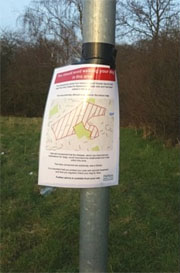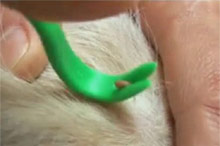Canine Babesiosis Outbreak Warning
UK dog owners are being warned about an outbreak of the potentially fatal tick-borne disease Canine babesiosis.
 Reports today say 4 dogs in Harlow, Essex have been affected and that at least one of the dogs has sadly died while the others remain seriously ill. The council has signposted the area thought to contain the ticks.
Reports today say 4 dogs in Harlow, Essex have been affected and that at least one of the dogs has sadly died while the others remain seriously ill. The council has signposted the area thought to contain the ticks.
Currently the ticks that are carrying the Babesia canis parasite have been found in a relatively well defined area in fields in Harlow but fears are that the disease could and probably will spread throughout the UK.
Who is at risk?
Any dog is potentially at risk but dogs spending time outdoors especially in forest, grass or wooded areas are more at risk of tick bites and therefore of contracting a tick-borne disease. Warmer months, typically May to September, are also times of higher risk but with the recent mild winters ticks could be about at any time of the year.
Symptoms
Babesia are protozoal parasites that attack red blood cells, initially causing anaemia. Canine babesiosis has an incubation period of about two weeks but sometimes the early symptoms can be mild and it may therefore go undiagnosed for months.
Symptoms include:
- Lack of energy
- Weakness
- Loss of appetite
- Pale mouth and gums (anaemia)
- Fever
- Inflammation
- Enlarged lymph nodes
- Orange or red urine
- Discoloured stools
- Yellow eyes or skin (jaundice)
- Weight loss
How to protect your dog
Canine babesiosis is difficult to diagnose, hard to treat and can be fatal. Prevention is better than cure.
Because Canine babesiosis is spread via infected ticks, an anti-tick treatment such as spot-on treatments or a tick collar should be effective. Check that the product is indeed a tick prevention treatment as some spot-ons may not be.
Vigilance is also key. A thorough inspection of every part of your dog's skin and coat after every walk, looking for and safely removing any ticks, is a sensible precaution. Having said that, young ticks and newly attached ticks can be tiny and difficult to find. Please also note that the longer the tick is attached to your dog the more likely the spread of any disease. Ticks only needs to have been feeding for 24 hours to spread diseases.
How to safely remove a tick

If you do see a tick on your dog, safe removal is incredibly important. If you remove the tick incorrectly this can actually make the tick regurgitate potentially infectious fluids into your dog. I can't stress this enough. Correct tick removal is essential. Please read How to Remove a Dog Tick.
Important - never ever apply ANYTHING to the tick in order to try to remove it from your dog. Do not apply heat or cold or any substance, be it Vaseline, nail polish remover or anything else at all.
Treatment
As mentioned, these tick-borne diseases are not easy to diagnose or treat. Often a mildly affected dog in otherwise good health can be treated with drugs as an outpatient but it can be a long road to recovery with no guarantees that a relapse won't occur. More seriously ill dogs may have to be hospitalised and undergo fluid replacement and blood transfusions.
If you find a tick on your dog, remove it safely and seek advice from your vet.
By Jenny Prevel
© D for Dog www.dfordog.co.uk
This article belongs strictly to D for Dog and we do not authorise the copying of all or any part of it.
